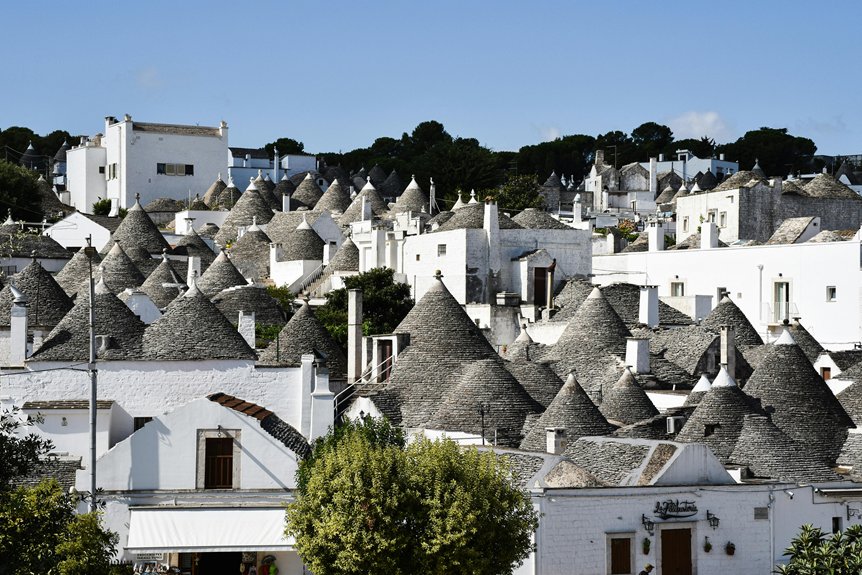Cyprus’s church architecture reveals a mesmerizing narrative of spiritual and cultural evolution. You’ll discover Byzantine domed structures in the Troodos Mountains, where sacred geometry and intricate frescoes transform each church into a theological canvas. From cross-in-square layouts to Gothic and Ottoman influences, these heritage sites capture centuries of architectural innovation. Explore UNESCO-recognized monuments that whisper ancient stories through every meticulously carved stone and illuminated space.
Key Takeaways
- The Troodos Mountain UNESCO World Heritage churches represent pinnacle examples of Byzantine ecclesiastical design, showcasing intricate architectural principles and spiritual symbolism.
- Cypriot church architecture integrates complex design elements like cross-in-square layouts, elaborate domes, and strategic light management to create transcendent worship spaces.
- Historical architectural influences from Byzantine, Gothic, and Ottoman periods are visually embedded in Cyprus’s religious structures, reflecting cultural transformation and artistic evolution.
- Preservation efforts by the Department of Antiquities focus on maintaining structural integrity and restoring delicate frescoes in historic religious sites like Panagia Asinou.
- Sacred geometry and iconographic storytelling are fundamental architectural components, with each church design communicating theological narratives through spatial arrangement and decorative elements.
Byzantine Church Design Principles in Cyprus
Though Byzantine church architecture in Cyprus represents a complex architectural tradition, its design principles reflect a profound spiritual and aesthetic philosophy. When exploring this byzantine church architecture cyprus guide, you’ll discover that churches like Agios Lazaros and Panagia Asinou embody sophisticated design strategies centered on creating transformative worship spaces.
You’ll notice key architectural elements that define the Byzantine style: intricate domes, carefully planned cross-in-square layouts, and meticulous light management. Controlling natural illumination wasn’t merely a structural choice but a deliberate method to craft a transcendent atmosphere. Elaborate stone carvings, vibrant frescoes, and religious iconography weren’t decorative afterthoughts but integral components communicating theological narratives.
The Troodos region’s UNESCO World Heritage churches exemplify these principles, where every architectural decision-from mosaic placement to dome construction-serves a deeper spiritual purpose. By understanding these design nuances, you’ll appreciate how Byzantine church architecture in Cyprus transformed physical spaces into profound spiritual experiences.
Architectural Evolution of Troodos Mountain Monasteries
How did the rugged terrain of the Troodos Mountains shape the distinctive architectural evolution of Cyprus’s medieval monasteries? The challenging landscape demanded innovative design strategies, resulting in unique ecclesiastical structures that blended Byzantine, Gothic, and local architectural traditions. Churches like Panagia Asinou and Agios Nikolaos tis Stegis exemplify this adaptive architectural approach, with their compact footprints and distinctive features strategically integrated into the mountainous environment.
Each monastery represents a complex layering of architectural techniques developed over centuries. The Church of Archangelos Michael in Pedoulas and Panagia tou Araka showcase how local builders synthesized external influences with indigenous design principles. Wooden roofs, intricate fresco work, and compact structural forms reflect both functional necessity and artistic sophistication. These churches weren’t merely religious spaces but sophisticated architectural responses to the challenging topographical constraints of the Troodos region, demonstrating remarkable engineering and aesthetic ingenuity.
Spiritual Symbolism in Cypriot Church Structures
Sacred geometry pulses through the architectural veins of Cypriot churches, transforming each structure into a profound theological narrative. You’ll discover that every architectural element carries deep spiritual significance, from the cross-in-square plan symbolizing Christ’s crucifixion to the strategic east-facing orientation representing divine illumination.
Key symbolic architectural features include:
- Domed ceilings represent the celestial domain, creating a visual connection between earthly worship and heavenly transcendence
- Intricate frescoes and mosaics serve as visual scripture, communicating religious teachings through elaborate iconographic storytelling
- Sacred relics embedded within church structures imbue spaces with spiritual authenticity, transforming architectural sites into living theological expressions
Window placements meticulously control natural light, creating an ethereal atmosphere that mirrors Christian theological concepts of illumination and spiritual revelation. Each architectural detail becomes a carefully crafted theological statement, inviting worshippers to experience a multisensory spiritual journey through spatial design and symbolic representation.
Preservation and Restoration of Historic Religious Sites
Because the architectural heritage of Cyprus represents a delicate tapestry of religious and cultural significance, the preservation and restoration of historic religious sites demand meticulous, interdisciplinary approaches. The Department of Antiquities plays a critical role in safeguarding these invaluable monuments, implementing exhaustive conservation strategies that protect Byzantine churches and monasteries.
You’ll find that restoration efforts focus on several key methodologies: structural reinforcement, careful cleaning of delicate frescoes, and strategic interventions that maintain architectural integrity. International funding from the European Union and specialized organizations has been instrumental in supporting these sophisticated preservation initiatives.
Landmark sites like the Church of Panagia Asinou, a UNESCO World Heritage Site, and the Church of Agios Lazaros in Larnaca exemplify successful restoration projects. These interventions not only preserve physical structures but also safeguard the rich cultural narratives embedded within Cyprus’s ecclesiastical architectural landscape, ensuring that future generations can appreciate and study these remarkable historical treasures.
Influence of Cultural Periods on Church Architecture
Throughout centuries of dynamic cultural interactions, Cyprus’s church architecture emerged as a profound representation to the island’s complex historical narrative. You’ll discover architectural styles that reflect multiple civilizations’ influences, revealing layers of historical changes through intricate design elements.
Cyprus’s architectural landscape: a tapestry of cultural dialogues woven through stone, symbolizing centuries of profound historical transformations.
Key architectural developments include:
- Byzantine churches showcase elaborate stone craftsmanship, featuring cross-in-square plans and ornate dome structures that symbolize spiritual and cultural sophistication
- Gothic cathedrals introduced European architectural innovations, characterized by pointed arches and expansive stained-glass windows that dramatically transformed religious spatial experiences
- Ottoman architectural interventions blended Islamic design principles with existing structures, creating unique hybrid monuments like the Selimiye Mosque that demonstrate cultural synthesis
Each architectural period represents a distinctive chapter in Cyprus’s rich cultural heritage. The architectural evolution demonstrates how religious structures transcended mere functional spaces, becoming powerful visual narratives of historical shifts, cultural exchanges, and artistic expressions that capture the island’s complex geopolitical journey through centuries of change.
UNESCO World Heritage Churches of Cyprus
While Cyprus boasts a remarkable ecclesiastical heritage, its UNESCO World Heritage Churches represent the pinnacle of architectural and cultural preservation. You’ll find these exceptional sites showcase Byzantine and medieval architectural traditions, with the most prominent being the painted churches in the Troodos region. These ten churches, inscribed collectively by UNESCO, demonstrate extraordinary architectural integrity and remarkable fresco preservation.
You’ll discover that these churches represent unique examples of Byzantine and post-Byzantine religious architecture, dating from the 9th to 16th centuries. Each structure reflects intricate architectural techniques, sophisticated artistic expressions, and profound cultural significance. Their compact, cross-in-square designs, adorned with exceptional wall paintings, illustrate complex theological narratives and artistic mastery.
The UNESCO-designated churches, such as Panagia Angeloktisti in Kiti and the Stavros tou Agiasmati church, offer you unparalleled insights into Cyprus’s rich religious architectural evolution, serving as critical repositories of medieval artistic and spiritual heritage.
Frequently Asked Questions
Can Tourists Enter and Photograph Inside Historic Cypriot Churches?
When visiting historic Cypriot churches, you’ll find photography policies vary. You’ll need to respect sacred spaces and local customs. Most Orthodox churches allow discreet, non-flash photography, but some strictly prohibit it. Always ask permission from clergy or local guides before capturing interior shots. Reverence and cultural sensitivity are key-you’ll want to observe signage, follow posted guidelines, and be mindful of ongoing religious services or private moments of worship.
What Clothing Is Recommended When Visiting Religious Architectural Sites?
When you’re stepping into sacred spaces, dress like you’re walking on hallowed ground. Modest attire is vital: cover shoulders, avoid shorts, and opt for knee-length garments. Women should consider carrying a light scarf for head coverage if needed. Closed-toe shoes demonstrate respect. Archaeological sites and religious structures demand conservative dress that reflects cultural sensitivity and architectural reverence, ensuring seamless entry and minimal disruption to spiritual environments.
Are There Guided Tours Available Specifically for Church Architecture?
Guided tours focusing on church architecture are increasingly prevalent, offering you scholarly insights into structural design, historical significance, and artistic elements. You’ll find specialized architectural tours that explore deep into stylistic nuances, providing expert interpretations of ecclesiastical spaces. Professional guides often bring archaeological and art historical perspectives, helping you understand the intricate relationships between design, cultural context, and religious symbolism in these sacred architectural environments.
How Much Do Church Entrance Fees Typically Cost in Cyprus?
Ironically, while spiritual enlightenment is priceless, church entrance fees in Cyprus aren’t. You’ll typically encounter modest charges ranging from €2 to €5 per site. Byzantine and medieval churches often request minimal contributions, with some historic UNESCO World Heritage sites charging slightly higher rates. Archaeological significance and preservation efforts justify these nominal fees. Remember, these charges support essential restoration and maintenance of these architectural treasures.
Which Churches Offer the Most Impressive Byzantine Architectural Features?
Byzantine architectural marvels in Cyprus showcase intricate craftsmanship and spiritual symbolism. You’ll find the most impressive examples at Panagia Angeloktisti in Kiti and the Troodos Mountain churches, particularly Asinou and Stavros tou Agiasmati. These sites reveal stunning frescoes, elaborate dome structures, and precise stone masonry that reflect complex medieval architectural techniques. Their preserved interior decorations and structural integrity offer you an unparalleled glimpse into Byzantine ecclesiastical design.
Conclusion
You’ve journeyed through Cyprus’s sacred architectural landscape, where stone and spirit intertwine like intricate Byzantine mosaics. These churches aren’t merely structures, but living narratives of cultural resilience and spiritual transformation. From Troodos monasteries to UNESCO heritage sites, each architectural element reveals layers of historical complexity, inviting deeper understanding of Cyprus’s rich ecclesiastical heritage and its profound architectural dialogue across centuries.

Meet Natalie, who has lived on Cyprus for the last 10 years. She loves exploring the beautiful nature of the island, like quiet forests and untouched beaches. Natalie has lots of cool experiences to share. Join her as she talks about her adventures in Cyprus.

